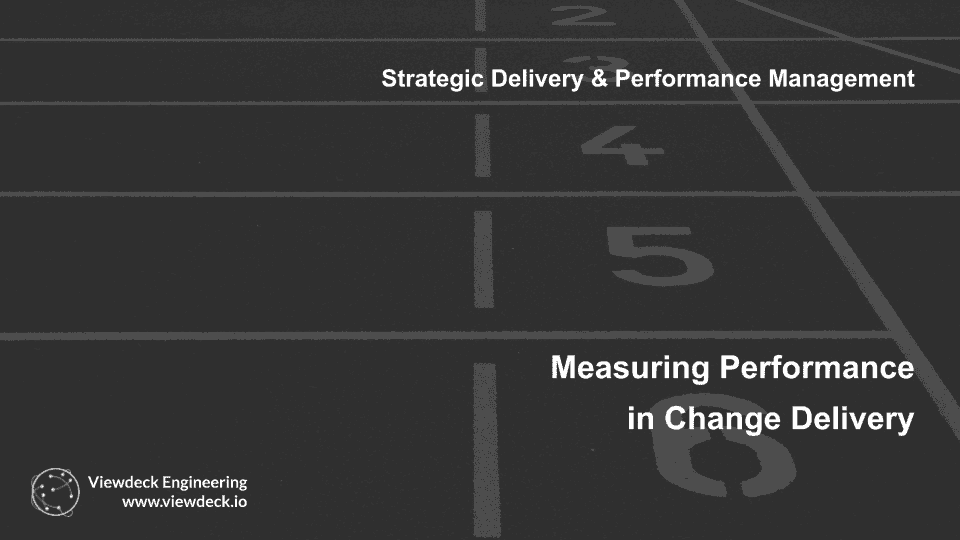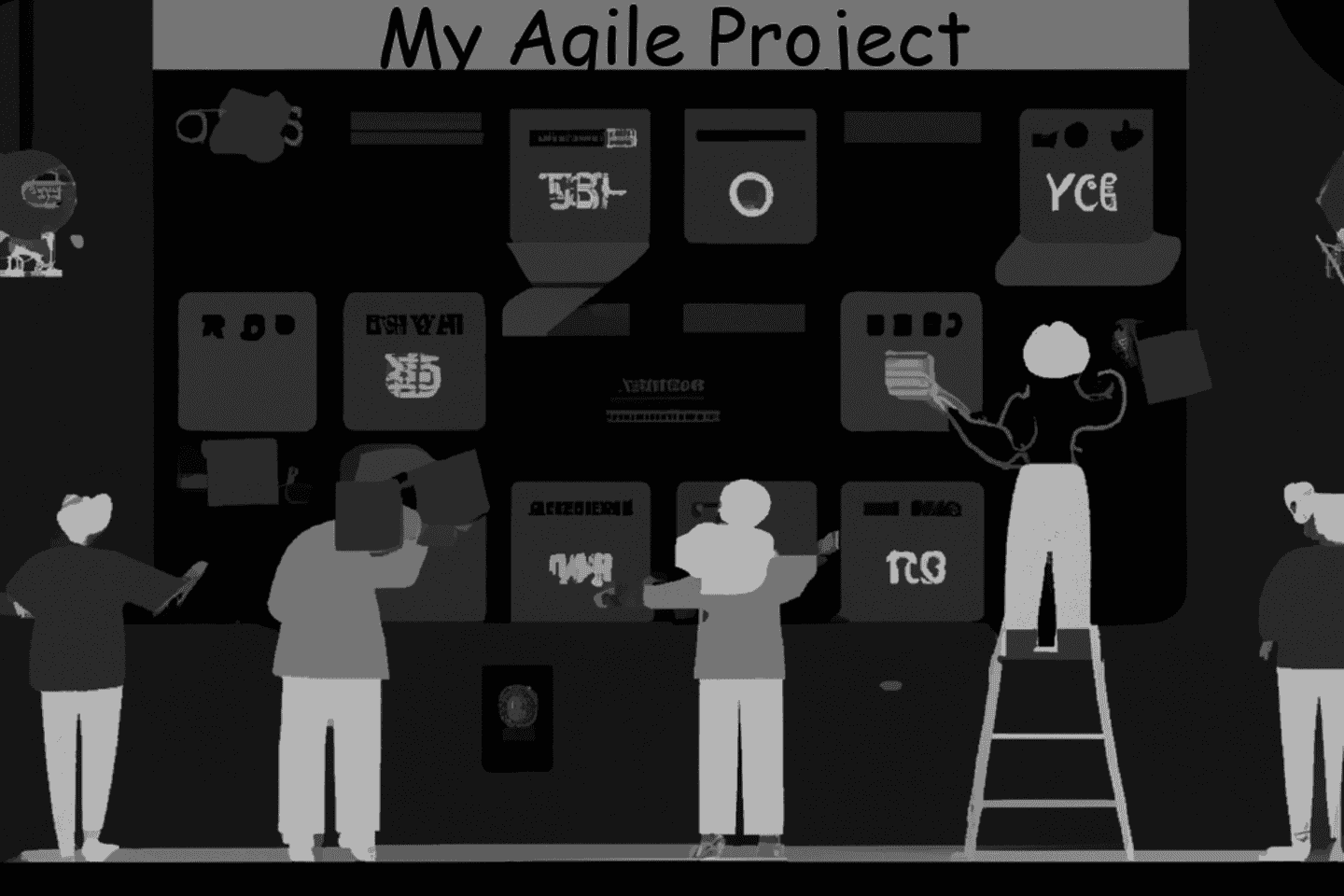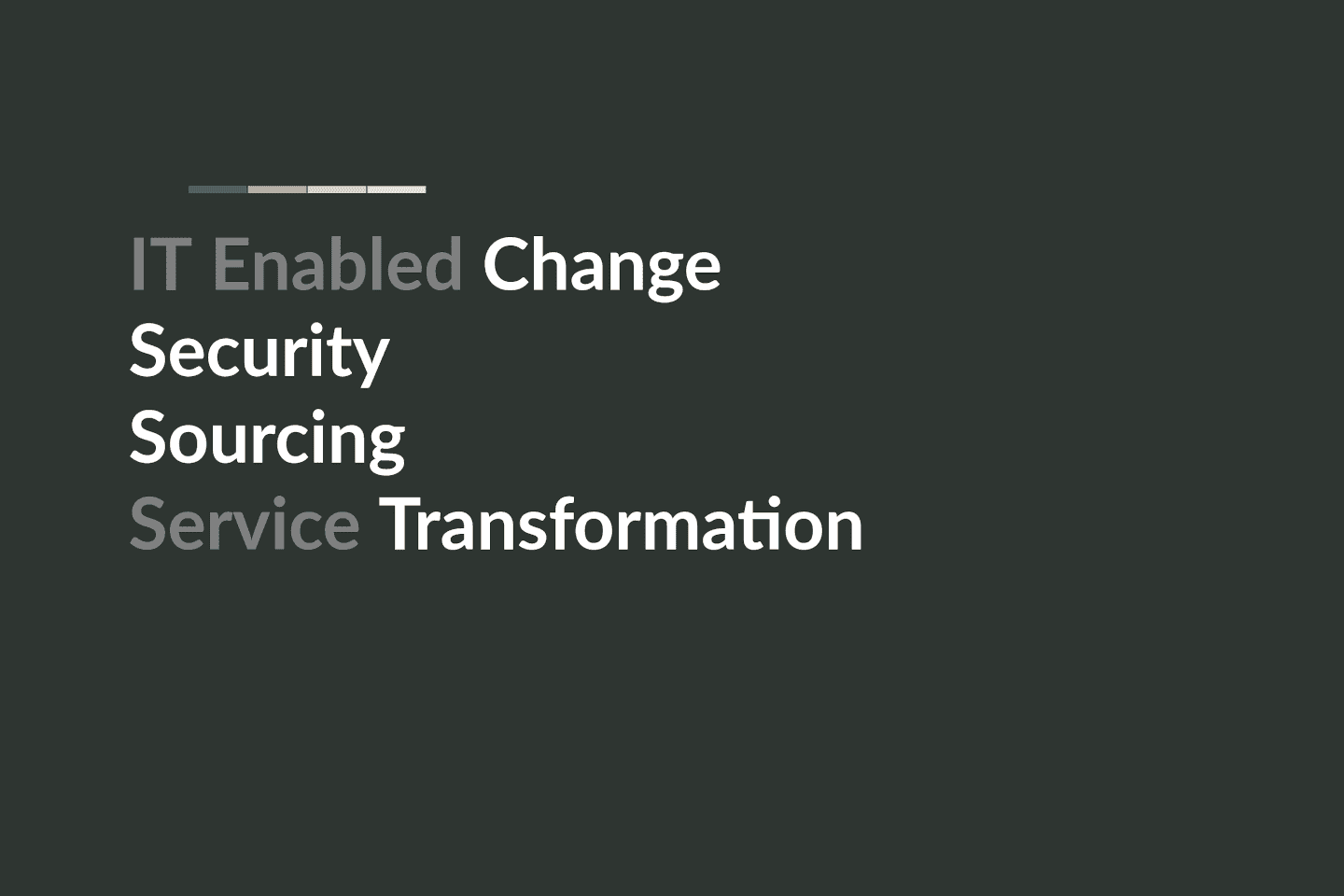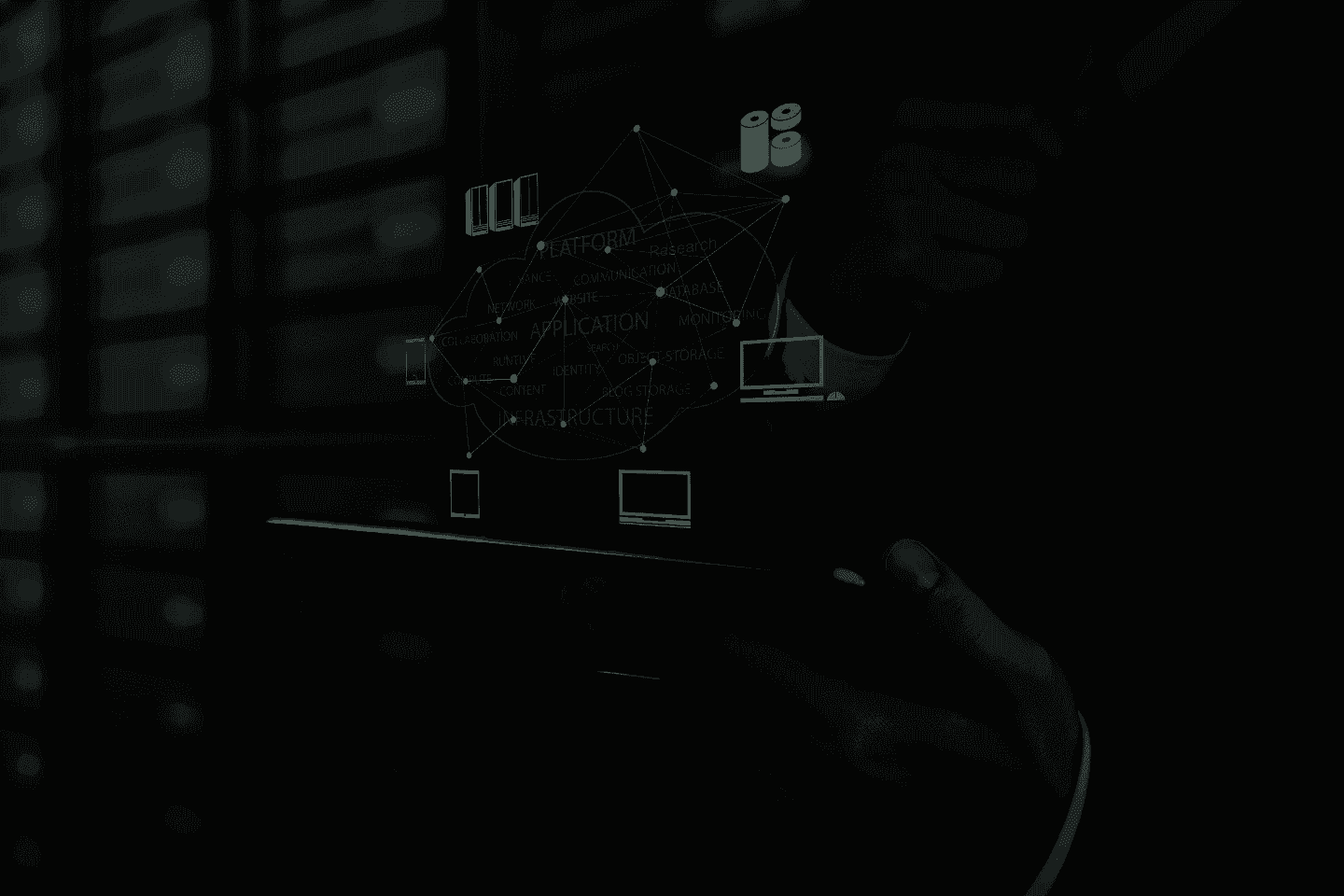Improving Service Delivery through the SIAM Maturity Model
By focusing on the business goals, and aligning Service Transformation activity that delivers benefits, the Service Management Maturity Model can provide an effective tool to understand, communicate and drive improvement.
Introduction
Maturity Models can be used to improve quality and efficiency in service delivery by providing an standard, easy to communicate tool, that can help guide organisations in their drive for improved outcomes. The CMMI approach has been developed over the years ( CMMI Institute ), providing an effective management tool to identify areas of improvement and develop a plan to address them. (CMMI® is registered in the U.S. Patent and Trademark Office by Carnegie Mellon University.)
In this article, we look at how using Service Outcomes, with a tailored Maturity Model approach can help organisations to evaluate Service Delivery success and service delivery performance, and enable service owners to understand where and how it should focus its resources. We will look at how, in order to improve its service outcomes, we can measure the effectiveness of the delivery organisation, and understand the effectiveness of areas such as project management, software development, and quality control, in order to meet business and stakeholder goals..
Service Integration and Management (SIAM) & ITIL
The Service Integration and Management (SIAM) framework is an approach to integrating and managing multiple external service providers within an organisation. It provides a structured approach for managing relationships with multiple suppliers, allowing organisations to manage their services more effectively, increase transparency and reduce costs. The SIAM framework consists of six core elements:
- organisational structures,
- governance processes,
- service management processes,
- supplier management processes,
- service level management processes and
- financial management processes.
Through adoption, services can be delivered in a consistent, cost-effective manner that meets their business needs. The SIAM framework is closely linked to ITIL (Information Technology Infrastructure Library), which provides best practice guidance for IT service delivery. ITIL and SIAM can be used together to ensure that services are delivered in an efficient and effective manner.
SIAM and Service Improvement Goals and Objectives.
While each organisation will have difference set of goals and objectives, depending on their business strategy, stakeholders and underlying objectives, the following set of Objectives are typical in most complex Service environments.
1. Improved customer service: Effectively manage customer expectations, ensuring that customer needs are met quickly and efficiently. This leads to better customer satisfaction and loyalty. 2. Increased operational efficiency: Provide businesses with the tools and processes to streamline operational processes, making them quicker, easier, and more cost-effective. 3. Improved customer experience: Providing a seamless experience across all channels. Customers can have a consistent experience no matter which channel they use. This helps build trust and customer loyalty. 4. Reduced costs: Through automation, organisations can reduce labour costs, leading to significant savings for the organisation in the long run. 5. Improved security: Ensure that data is secure and remains confidential, increasing protection against cyber threats and other malicious activities.
The key Activities of SIAM delivery
In order to measure progress and maturity in Service Delivery, (and meet our objectives), we to identify the key activities and outcomes at the heart of the Service process. The following key goals summarises the core capabilities of a SIAM or Service Management approach, that help provide the key dimensions we should be considering on our evaluation model. These activities should contribute to our Goals/Objectives ( outlined above ), and as part of the Benefits Management process, we would look to able to place a value against each.
-
Service integration: Bring together multiple services from different providers into a single, unified delivery model.
-
Service orchestration: Coordination and management of multiple services and components to ensure delivery of the intended outcomes.
-
Automation: Automating routine tasks and processes to reduce manual effort and improve operational efficiency.
-
Governance and monitoring: Establishing guidelines and controls that promote visibility and compliance across the IT landscape.
-
Risk management: Identifying potential risks associated with service delivery, and establishing procedures for mitigating them.
-
Service assurance: Ensuring that services are delivered in line with requirements, and that any changes or updates are monitored and managed appropriately.
-
Cost optimisation: Re-evaluating service costs on a regular basis to ensure value for money is being achieved.
Using these outcomes as a guide, we can better identify risks, optimise and develop processes that are aligned, and drive efficient and repeatable services. Maturity Models provide a framework for measuring performance and progress against these goals, enabling organisations to assess their progress on an ongoing basis, to establish best practices and thus create a competitive advantage in the marketplace.
The SIAM Maturity Model
Maturity Models provide a score identifying the assured level or maturity that a process or capability has reached. In our SIAM Maturity Model we will adopt the standard approach used across other similar models, with a Score of 1(lowest) - 5(highest) maturity. Levels 1-5 are typified by the following labels:-
- Initial/Ad Hoc: This is the first level of maturity, characterised by a lack of standard processes and procedures. Organisations at this level may have informal processes that are applied inconsistently or without consideration of the organisation’s overall goals.
- Repeatable: At this stage, there are established processes and procedures in place. These processes are used consistently and can be repeated with similar results each time.
- Defined: This level involves creating more formalised and documented processes and procedures, as well as establishing standards for repeatability across different departments and teams.
- Managed: Here, the organisation has a better understanding of how to measure their performance against established standards and can use these metrics to make improvements to their processes.
- Optimised: The highest level of maturity is achieved when an organisation is able to continuously improve their processes, taking into account factors such as cost, quality, and customer satisfaction.
Maturity Indicators
To align with out SIAM outcomes ( summarised above ) and ensure that our Model aligns well to our business needs, the SIAM model proposed looks across the following 5 dimensions or attributes, to help consider delivery structures against different aspects or organisational delivery.
1. Ownership & Governance The Ownership aspect of Service Management/SIAM relates to the roles and responsibilities of the various stakeholders involved in the service management process. This includes defining ownership and roles for each stakeholder, understanding their capabilities and setting expectations for their performance. It also involves establishing processes for ensuring that the stakeholders are following agreed upon procedures.
Governance focuses on the setting and enforcing of policies, standards, and procedures to ensure that services are managed in a consistent manner. This includes establishing the Service Level Agreements (SLAs) between each stakeholder and the service provider, as well as identifying appropriate metrics for measuring service performance. Additionally, it involves creating a structure for reviewing service performance and addressing service issues in a timely manner.
2. Structure & Influence
The Structure aspect of Service Delivery Maturity focuses on the organisational structure, processes and systems of the service delivery organisation. It includes aspects such as the development of a service-oriented organisational structure, the deployment of appropriate process and system components, and the alignment of those elements to enable an effective service delivery capability.
The Influence aspects focuses on how the organisation's strategy and objectives are communicated to stakeholders and customers, how customer feedback is incorporated into decision-making, and how customer satisfaction is tracked and improved upon. It also includes activities such as developing customer engagement plans, establishing service level agreements (SLAs), and engaging in continuous improvement initiatives. These areas help identify services that are designed to meet their customers' needs and expectations.
3. Organisation & Capability
The Organisational aspects of Service Management maturity include considering
- Processes: Ensuring processes are documented, well-defined, and up-to-date.
- Governance: Examining how decisions are taken and ensuring that the appropriate levels of oversight are in place.
- Support: Evaluating the level of support available from internal and external sources.
- Knowledge: Assessing the knowledge base of staff, both in terms of technical expertise and understanding of Service Management/SIAM principles and frameworks.
- Culture: Checking whether there is a service-oriented culture across the organisation that encourages collaboration, communication and innovation.
- Technology: Assessing whether the right tools are being used to manage services and ensure their effectiveness.
4. Communication
Measuring the maturity of communication processes in relation to Service Management/SIAM involves identifying how well the organisation is able to communicate information between different departments and stakeholders. This can be done by assessing the speed and accuracy of communication, how well the different teams are able to collaborate, and how effective communication is when resolving issues. Additionally, the quality of communication within Service delivery, such as how effectively they are able to share information and provide feedback. Lastly, measuring ability to maintain consistent level(s) of communication across different channels and environments.
5. Participation & Integration
Measuring the maturity of Participation & organisational Integration in relation to Service Management/SIAM looks at the organisations processes, policies and systems. This includes the evaluation of operational performance, customer satisfaction, service level agreements, financial stability and how well the organisation communicates with its customers and stakeholders. This also includes how well an organisation has been able to integrate its different departments and teams in order to achieve maximum efficiency.
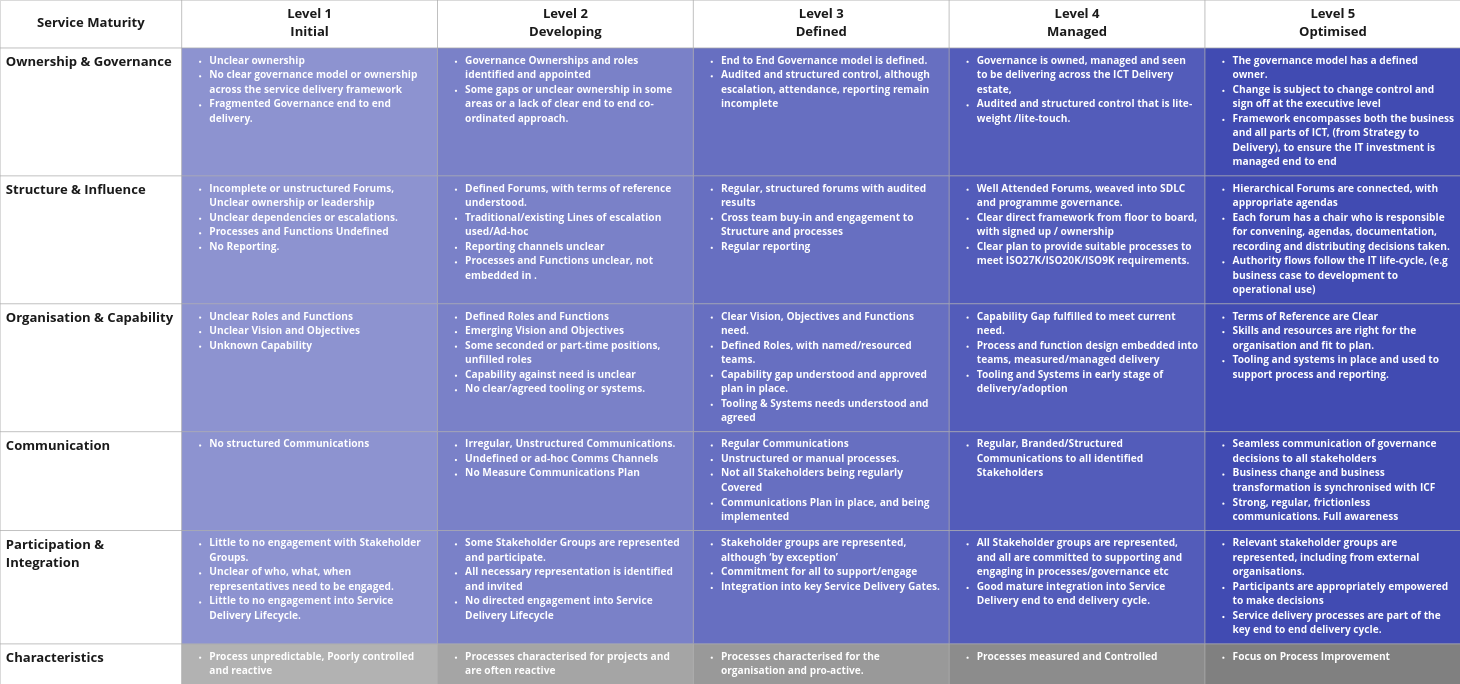
The Maturity Assessment Process.
After assessing the current level of process maturity with the Maturity Model, an organisation can then take actions to improve their processes and practices to increase their process maturity. This could include implementing new processes and procedures for project management and software development, creating standards for quality control, or instituting training programs that focus on improving personnel skills in these areas.
The following 7 step process identifies the standard approach to making that first 'iteration' in assessing, interpreting and improving the "Maturity", as well as then iterating improvements to meet the goals.
1. Define the Scope: Determine what will be assessed and at what level of detail. This should include which processes, activities, roles, and resources will be included in the assessment.
2. Establish Goals and Objectives Define the purpose of the assessment and identify any specific objectives that should be achieved. For example, is the goal to improve process efficiency or increase customer satisfaction? Your Maturity Model must have buy-in from the senior stakeholders/leadership team, and clearly represent the core values and vision. By engaging Service Owners/Stakeholders, identify where they believe the current maturity is, and what the tactical and strategic objects are for the Service delivery are ( aligned to Business strategy). At this stage you might find areas of the model that are not right for your Goals & Objectives, and it makes sense to re-align your Model.
3. Gather Data Using each Dimension of your model as a guide, collect data related to the scope and objectives of the assessment, through interviews, surveys, observations, and service data etc. This should be collected from relevant stakeholders such as customers, employees, managers, partners, stakeholders etc.
4. Analyse Data Taking each Dimension/Attribute in turn, analyse the data collected and compare it against the Maturity Model. Identify the Level that best characterises each dimension. This will provide an understanding of where the organisation is currently in terms of maturity, and which areas need improvement or further development.
5. Develop Action Plan Based on the results of the analysis, develop a benefits model and an action plan to address any areas needing improvement or further development. This change plan should include specific goals and objectives, ideally expressed in terms of User Experience ( or Stories ) and Feature improvements that the business can understand and recognise. The resource plan, aligned to the benefits model, should include the timeline for achieving each step improvement (Dimension improvement) against the model. Develop the Business Case and supporting stakeholder ownership to ensure ownership, buy-in and success ( aligned to those changes/steps in each Dimension). This enables the business to evaluate the value in making each step in Maturity Improvement, and help prioritise the delivery.
6. Implement Plan With the agreed Change plan, suitably resourced, establish the governance and delivery structures to ensure business engagement and stakeholder governance. Implement the change, ideally through an iterative Agile process, delivering against each of the improvement objectives. There are many ways to implement Service Change, but an Agile approach that focuses on delivering outcomes (Features) based on user journeys provides clarity to business and service owners, as well as ensuring change is focused on business value (aligned to Business Benefits)
7. Monitor Progress At each delivery step, review the data against the model, and track the progress towards achieving the goals and hence improvement against the Maturity objectives. Progress in Maturity should be shared with the key stakeholders ( as part of the communication plan ) at each release or realisation of the benefit(s) so value can be demonstrated. Confirm the benefits realisation. If progress is not being made as expected ( Improvements in Maturity Dimensions) then refine the change plan, revise the benefits model, and agree the actions to improve.
This seven step process provides the ideal conditions to provide the success ( vale for money/benefits ) for the business. Taking an iterative approach enables the business to prioritise activity to meet the goals as well as refine the objectives as impacting external change impacts the scope of the improvement.
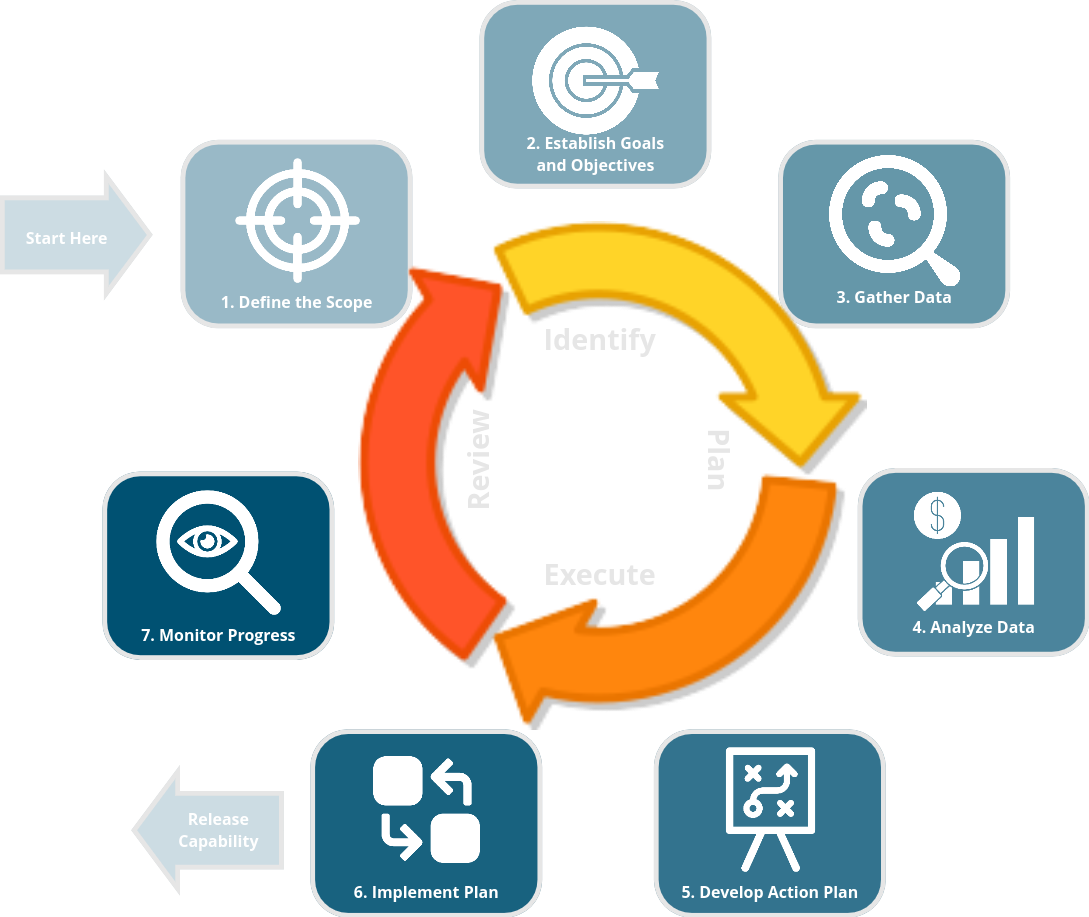
Maturity in Service Management is typically measured by assessing the current service delivery capabilities against some standard of best practices, with Processes, organisation structure and technology being important factors when measuring maturity. As defined in ITIL, the focus of any Maturity process is on continuous improvement and the ability to deliver services that meet customer expectations in a cost effective manner. Measuring maturity requires an understanding of the service management processes, organisational structure, technology and tools used, as well as the level of customer satisfaction achieved. On the back of the Maturity Model, Key performance indicators (KPIs) should be established and monitored to measure progress towards achieving the desired maturity level.
Conclusion
By focusing on the business goals, and aligning Service Transformation activity that delivers benefits, the Service Management Maturity Model can provide an effective tool to understand, communicate and drive improvement. Through aligning change delivery around the right service improvements ( captured in the Model), business can focus resources, measure progress and demonstrate measurable improvements as a result from improving delivery maturity. SIAM and Service Improvement is all about Improved customer service, Increased operational efficiency, Improved customer experience, Reduced costs, and improved security. The Service Management Maturity Model is the important 'Score Card' to help the business focus its resources, and prioritise its limited change capacity.

